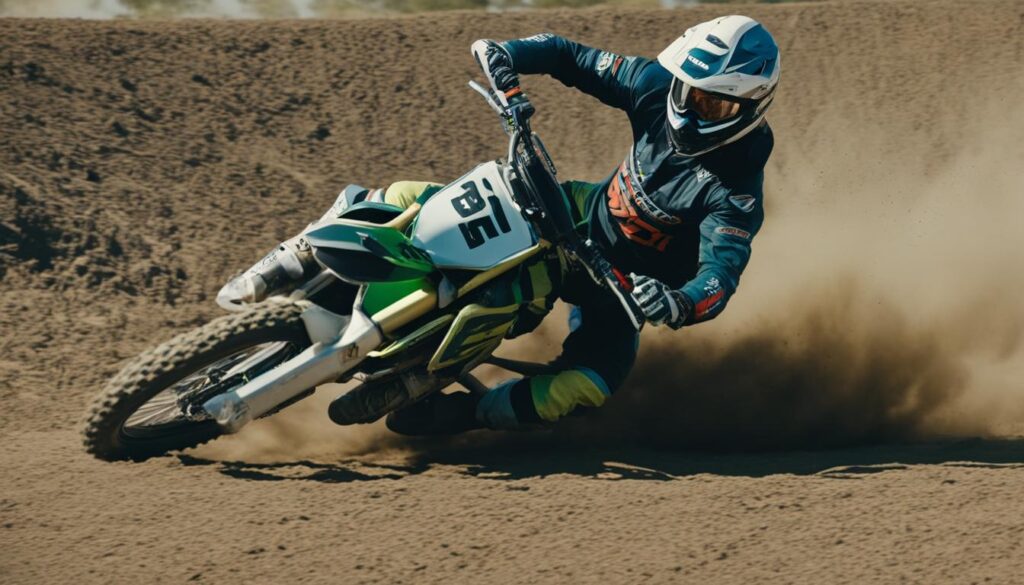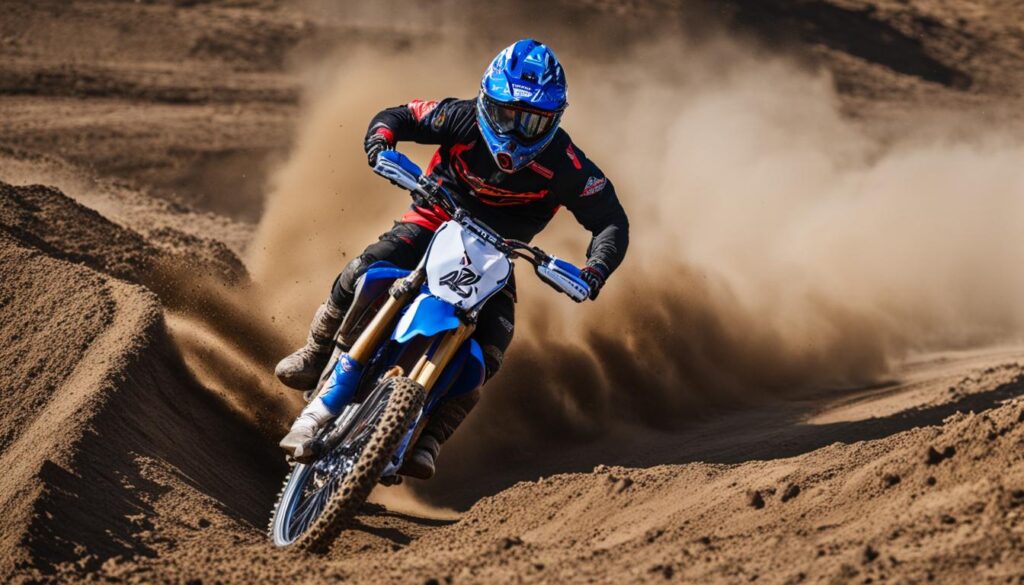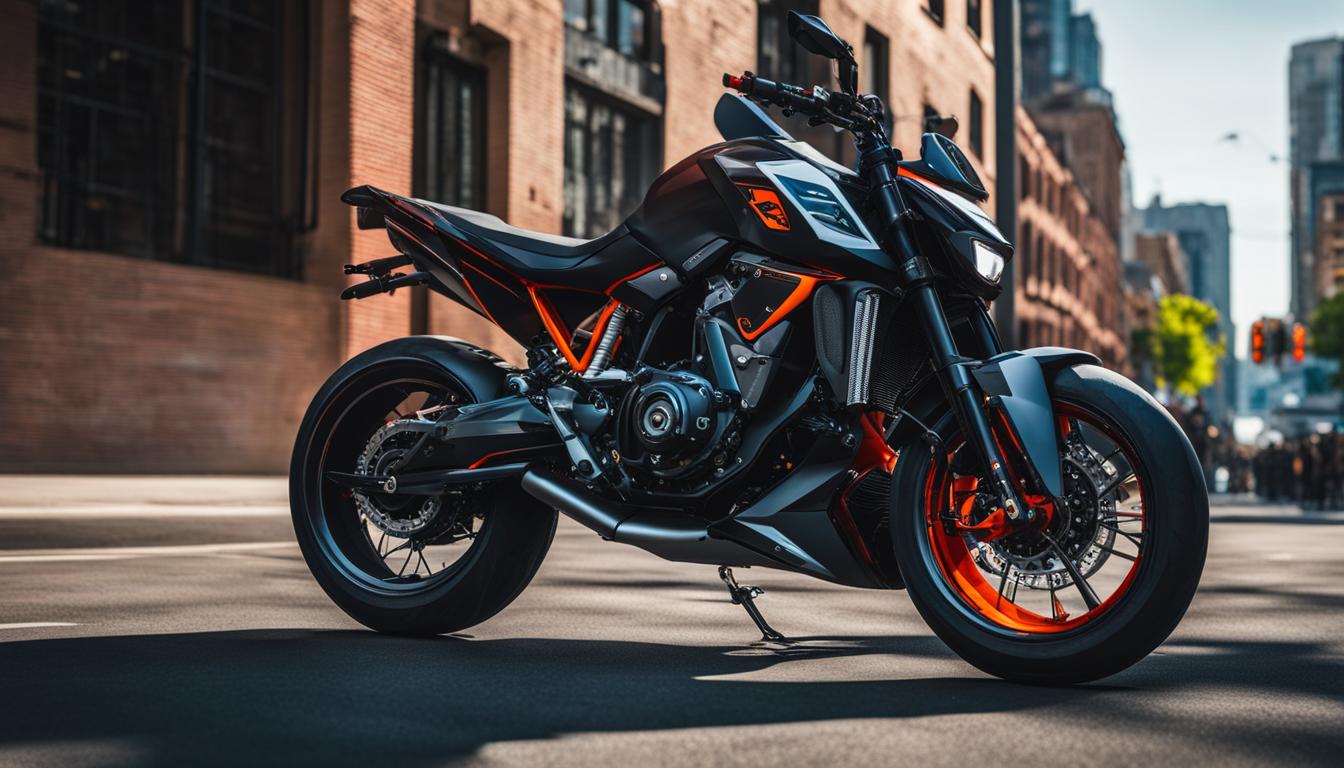Welcome to the beginner’s guide to riding a dirt bike! If you’re passionate about off-road adventures and want to explore the exhilarating world of dirt bike riding, you’ve come to the right place. Riding a dirt bike requires mastering various techniques and skills that will enhance your riding experience, improve your performance, and ensure your safety on the trails. In this guide, we’ll provide you with some essential tips and tricks for mastering the basics of dirt bike riding. Whether you’re a complete beginner or have some experience under your belt, these valuable insights will help you become a more skilled and confident dirt bike rider.
Key Takeaways:
- Focus on body positioning, clutch control, balance, and braking to enhance your riding skills.
- Practice standing while riding to improve control and maneuverability.
- Master foot positioning and weight transition for better control in corners.
- Learn proper braking techniques to ensure speed control and safety.
- Maintain the right head position and practice visualization for enhanced safety and performance.
Practice Standing While Riding
One of the fundamental skills in dirt bike riding is learning how to ride in a standing position. While most beginners feel more comfortable riding while seated, standing offers better control and maneuverability. The attack position, characterized by centered body weight, bent knees, raised elbows, and a firm grip on the bike, allows for enhanced control and quick reactions to unexpected situations. Practicing standing while riding is crucial for improving riding skills, safety, and overall performance.
When riding in a standing position, your weight is evenly distributed, providing more stability and control over the bike. This allows you to react quickly to changes in terrain and maintain better balance. However, it’s essential to maintain proper body positioning to maximize the benefits of standing while riding.
To assume the attack position, follow these key tips:
- Keep your body centered over the bike by aligning your head, chest, and feet in a straight line.
- Bend your knees slightly to absorb the impact of bumps and maintain a stable position.
- Raise your elbows to create a strong and balanced posture.
- Grip the bike firmly with your legs to maintain control during acceleration, braking, and turns.
By practicing standing while riding, you’ll develop better bike control, allowing you to navigate challenging terrains with confidence and precision. Additionally, standing offers improved visibility, allowing you to anticipate obstacles and hazards more effectively.
Remember to start practicing on flat, open terrain before attempting more advanced techniques. Gradually build your skills and confidence over time. Regular practice will help you master the art of standing while riding and enhance your overall dirt bike riding experience.
Mastering Foot Positioning and Corners
Proper foot positioning plays a crucial role in controlling a dirt bike. Riding on the balls of your feet provides better access to the shifter and rear brake pedal, enabling efficient gear changes and braking. By maintaining this foot position, beginners can quickly adapt to different riding conditions and terrain, ensuring optimal control of the bike.
When it comes to cornering, technique and body positioning are key. While it may seem natural to focus on turning the handlebars, weight transition is actually more important for maintaining balance and stability. By applying pressure on the handlebars and shifting your body weight in the direction of the turn, you can effectively navigate corners with greater control.

An essential tip for smooth cornering is to avoid fixating on the front wheel. Instead, look ahead to where you want to go. This helps you anticipate the trajectory of the bike and maintain a steady flow through the corner. By practicing proper foot positioning and mastering cornering techniques, beginners can confidently navigate turns and enjoy a safer and more enjoyable dirt bike riding experience.
Mastering Braking Techniques
When it comes to dirt bike riding, mastering braking techniques is crucial for both safety and control. As a beginner, it’s important to understand the proper way to brake to avoid accidents and ride with confidence. Here are some essential tips to help you master the art of braking on a dirt bike.
Even Pressure on Both Brakes
One common mistake beginners make is stomping or grabbing the brakes instead of applying even pressure. To brake effectively, it’s important to use both the front and rear brakes simultaneously. This distributes the braking force evenly and helps maintain stability. Applying too much front brake can cause the bike to flip, while excessive rear brake may result in the rear tire sliding sideways. By applying even pressure, you can achieve a smooth and controlled stop.
Transitioning Finger Position
Proper finger positioning is another key aspect of mastering braking techniques. As a beginner, it’s natural to use all four fingers on the brake and throttle levers. However, as your skills progress, transitioning to using three fingers can greatly improve your control and maneuverability. By using your index, middle, and ring fingers, you’ll have a better grip on the handlebars and enable quick and seamless shifting and braking.
Clutch Control for Speed
Once you’ve become comfortable with using the brakes, it’s time to explore the use of the clutch for better speed control. The clutch is a valuable tool that allows you to disengage the engine power when shifting gears or navigating tricky terrain. By coordinating the use of the clutch with the brakes, you can effectively manage your speed and maintain balance. Practice using the clutch in conjunction with the brakes to enhance your control and confidence on the dirt bike.
| Braking Techniques | Tips |
|---|---|
| Apply even pressure on both front and rear brakes | Ensure a smooth and controlled stop |
| Transition from using all four fingers to three fingers on the brake and throttle levers | Improve grip, control, and maneuverability |
| Coordinate the use of the clutch with the brakes | Enhance speed control and maintain balance |
With practice and proper technique, you’ll be able to confidently apply the brakes, control your speed, and navigate any terrain with ease. Remember to always prioritize safety and gradually push your limits as you become more comfortable and experienced on your dirt bike.

The Importance of Head Positioning and Visualization
When it comes to dirt bike riding, keeping your head up and looking ahead is absolutely crucial. Not only does it enhance your safety, but it also improves your overall riding performance. By scanning the horizon and looking as far ahead as possible, you give yourself more time to react to obstacles and potential hazards that may come your way.
But it’s not just about safety. Proper head positioning plays a significant role in influencing your body movement on the bike. You’ll notice that your body tends to follow the direction of your eyes. So, if you’re looking in the right direction, your body will naturally adjust accordingly.
To further enhance your riding skills, visualization is key. Take the time to observe professional riders or analyze your own videos to see correct riding form and body position in action. This visualization technique helps you identify areas for improvement and track your progress over time.
So remember, always keep your head up, look ahead, and visualize your ideal riding form. It will not only make you a safer rider but also elevate your dirt bike riding skills to the next level.
Note: Visualizing correct riding form and body position can greatly enhance your dirt bike riding skills.
Get Plenty of Practice
Like any skill, mastering dirt bike riding requires practice. Consistent and focused practice drills are essential for improving technique and building confidence. By dedicating time and effort to regular practice, you can enhance your dirt bike riding skills and become a more skilled rider.
- Concentrate on one specific skill or drill for at least ten to fifteen minutes before embarking on a recreational ride. This focused approach ensures proper technique development and allows you to hone your skills in a controlled environment.
- Remember to prioritize technique over speed. It’s tempting to focus on going faster, but mastering the fundamentals is crucial for long-term progress. By establishing a solid foundation of skills, you’ll be able to ride with increased speed and safety.
- Plan regular practice sessions to incorporate into your routine. Set aside dedicated time for practice, whether it’s in a designated dirt bike riding area or a local track. Consistency is key to improving your abilities.
- Gradually develop your skills by progressing to more challenging drills and techniques. As you become comfortable with the basics, you can expand your repertoire and take on new riding challenges.
Remember, dirt bike riding is a continuous learning process. Each practice session is an opportunity to refine your technique and gain newfound confidence. With dedication and perseverance, you can become a better and more skilled dirt bike rider.
| Benefits of Regular Practice | Techniques to Focus On |
|---|---|
| Improves muscle memory | Body positioning |
| Enhances balance and control | Clutch control |
| Develops confidence | Braking techniques |
| Increases reaction time | Foot positioning |
| Builds endurance and stamina | Cornering |
| Refines riding technique | Standing while riding |
Conclusion
Riding a dirt bike can be an exhilarating adventure that offers endless excitement and challenges. To make the most of your dirt bike riding experience, it is crucial to master the basics. By focusing on essential components such as body positioning, brake and throttle control, balance, and core riding skills, beginners can enhance their skills and confidence on the bike.
Regular practice is the key to becoming a proficient dirt bike rider. Dedicate time to practicing specific skills and drills before embarking on recreational rides. Prioritize technique over speed, as mastering the fundamentals will ultimately lead to increased speed and safety in the long run. Consider seeking guidance from a professional mentor, as their expertise can provide valuable insights and help you progress faster.
Remember that safety should always be a priority when riding a dirt bike. Wear protective gear such as a helmet, goggles, gloves, and boots. Familiarize yourself with the rules and regulations governing dirt bike riding in your area and always ride within your limits. Enjoy the journey and have fun exploring the thrilling world of dirt bike riding!
FAQ
What are some essential tips for mastering the basics of riding a dirt bike?
Some essential tips for mastering the basics of riding a dirt bike include practicing standing while riding, mastering foot positioning and corners, mastering braking techniques, focusing on head positioning and visualization, and getting plenty of practice.
Why is standing while riding important in dirt bike riding?
Standing while riding is important in dirt bike riding because it offers better control and maneuverability. The attack position, which involves centered body weight, bent knees, raised elbows, and a firm grip on the bike, allows for enhanced control and quick reactions to unexpected situations.
How can I improve my foot positioning for better control?
To improve your foot positioning for better control, ride on the balls of your feet. This allows for better access to the shifter and rear brake pedal, ensuring efficient gear changes and braking.
What is the key to smooth and precise cornering?
The key to smooth and precise cornering is weight transition rather than turning the handlebars. By pressing the bars and using body weight to balance the bike through a turn, riders can maintain stability and control.
How should I brake effectively while riding a dirt bike?
To brake effectively while riding a dirt bike, avoid stomping or grabbing the brakes and learn to apply even pressure to both the front and rear brakes. It is also important to gradually transition from using all four fingers on the brake and throttle levers to using three fingers for better speed control and shifting.
Why is head positioning important in dirt bike riding?
Head positioning is important in dirt bike riding because keeping the head up and looking ahead is crucial for safety and improved riding performance. By scanning the horizon and looking as far ahead as possible, riders gain more time to react to obstacles and potential hazards.
How can I improve my dirt bike riding skills?
To improve your dirt bike riding skills, it is important to get plenty of practice and focus on specific skills or drills for at least ten to fifteen minutes before recreational rides. Prioritizing technique over speed and gradually developing core riding skills will lead to increased proficiency and safety.
How can I become more confident and skilled in dirt bike riding?
To become more confident and skilled in dirt bike riding, regular practice, patience, and the guidance of a professional mentor are essential. By prioritizing safety, having fun, and continually building on your skills, you can become a better and more skilled dirt bike rider.


